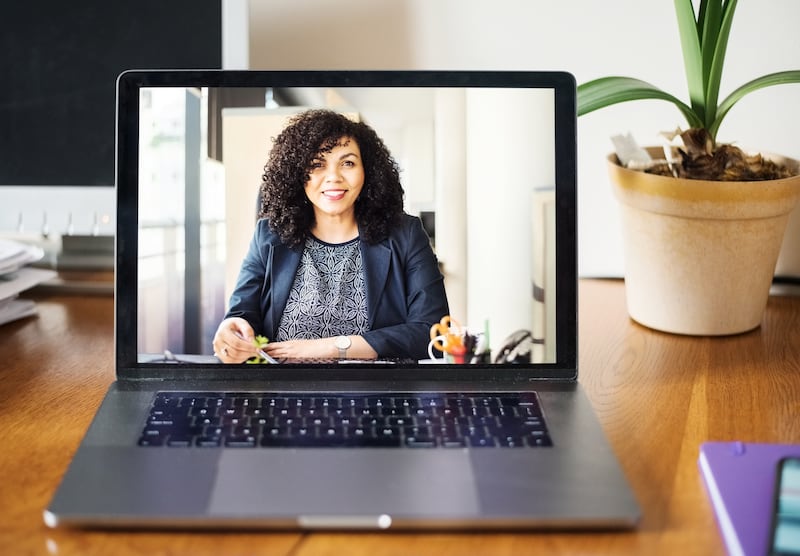If job interviews are awkward and nerve-racking at the best of times, this is magnified by the prospect of having to do it from a corner of your home on screen, while hoping your children or pets don’t put in an appearance. Unfortunately, the pandemic has made interviewing for a job via the internet an increasingly common experience. Here is some expert advice on how to look like a pro, even if you are wearing pyjamas from the waist down.
Know where you have to be and when
Is the interview on Zoom, or Microsoft Teams, or Google Hangouts or some other platform? Are you sure of the time (and time zone)? "Triple check the details – arriving a day early or late is hard to recover from," says Ruth Cornish, who runs the consultancy Amelore and is a cofounder of HR Independents, the UK body for independent human-resources professionals. Arrive early, but not too early – two or three minutes is fine. She knows of at least one person who signed in too early for an online interview and ended up crashing another. However, it depends on the platform; and some recruiters will have a "waiting room" and ask you to be there 10 minutes early – again, check the detail.
Practise using the technology
Download the software well in advance and familiarise yourself with the online meeting place, as well as your device – for added security, consider downloading it on to a second device, such as your phone, and practise using it on there too, in case your computer fails at a crucial moment. “The main thing I see is, people are uncomfortable with the technology,” says Cornish. “Their username [on the account] doesn’t come up correctly: it’s the name of their son or ‘iPad’ or something like that, which throws everybody off. Or the microphone or camera isn’t working.” If you plan to show slides or share your screen, make sure you know how to do it (and that there’s nothing embarrassing on your desktop screen).
See how you come across
Eye contact, especially when there isn't much else to go on, is especially important, says John Lees, career coach and author of Knockout Interview. "The mistake people make is talking to the face on screen and what you should do is talk to the camera," he says. "It does need a bit of practice. So it's a good idea to practise with a friend and, if you can, record the call and look at it afterwards." Do you need to move less or look into the camera more? "Eye contact really matters through the screen and does create an impression of direct communication."

Prepare your interview area
If you don’t have a spare room or office, commandeer a quiet corner at home and think about styling it for your interview. “You want a clear, uncluttered background that says something about you,” says Cornish. Push junk and clutter out of sight, maybe put a picture on the wall behind, or a tidy bookcase. “I’ve seen it all – piles of washing in the background, boxes, junk and rubbish. And your eye is just drawn to it. You want eyes to be on you, so nothing that will distract anybody.” She is not a fan of digital backgrounds, which can distort your outline and makes her wonder what people are hiding. While we’re still encouraged to work from home, you’re also showing your interviewer that your home workspace is suitable (even if you like to work from the sofa surrounded by biscuit crumbs). “If it’s chaotic or noisy, or there are interruptions, then you’re diminishing your chances because you’re really saying, ‘I’m not in control of this environment and it’s not a suitable place to work from’,” says Lees.
Lighting matters
“A couple of well-placed lights mean your face is lit from both sides, rather than above which makes people look strange,” says Lees. “Natural light is good, but if it’s just from one side, set another light on your other side. The more you create a feeling of a well-lit, professional environment the better because it shows you’re taking it seriously and it shows how you’re going to interact with other people in the organisation, and clients.”
Dress smartly
Don’t be lulled into dressing too casually, says Cornish. “We’re seeing a lot of hoodies. You still need to make an effort – not necessarily a jacket, but a smart top or shirt, or whatever is appropriate for your industry.” For men, says Lees, a tie looks strange at home but “smart casual” is appropriate. Bold colours work well on screen, says Cornish. But no busy prints or clashing colours, says Lees. “And nothing that’s more interesting than what you say,” he adds. What works for you? Does putting on proper shoes and a pair of smart trousers, even though neither will be seen, make you feel more alert and professional, or do you feel more comfortable and liberated in jogging pants?
Try to forget you are at home
This is still a formal situation. If you wouldn’t do it during an in-person, office-based interview, don’t do it on screen. Turn your phone off and don’t be tempted by leaving snacks within reach. “I’ve seen people file their nails or say ‘Don’t mind me, I’m just wrapping a present.’” That’s a bit extreme, she admits, but “people are a bit more casual than usual.” This is where recording yourself can be helpful – are you fiddling nervously with something on your desk without realising, or is your body language too casual (slouching, for example)? Don’t have anyone else in the room. “You wouldn’t take someone else to an interview,” she says. Even if they are quiet and not visible to the interviewer, “People can’t help looking at the other person and the interviewer will notice. You have got to connect with that interviewer, and have to work harder when you’re not in the same room, so anything that’s going to distract you is going to be negative.”

But don’t stress too much about it
Try to time an interview for when your toddler can be out of the house, or let your teenagers know not to eat up the wifi by gaming or streaming TV (and put a sign on your closed door so they know not to come in). But interviewers are fairly forgiving of life’s interruptions at the moment, says Cornish, and as long as it’s not too extreme it can create a shortcut to a rapport. “If your dog starts barking, which mine does all the time, that’s okay; it can be a bit of a laugh. We all know that people are working from home and doing their best. The interviewer is on your side.” If your technology fails, or the wifi drops out, “don’t let it become the focus”, says Cornish. “Deal with it calmly and confidently and don’t show your frustration.” Have a backup plan, such as using your second device, or asking in advance for a telephone number to continue via an old-fashioned phone call should the video connection fail (though do try one more time to connect). “Any unexpected hitch gives you an extra chance to demonstrate your resilience, quick thinking and professionalism.”
Build a rapport
Although tricky on screen, there are ways. A little small talk is appropriate, says Lees, but what really works is “being easy to talk to – that means listening to questions very carefully and not giving answers that are too long and rambling. Keep focus.” As awkward as you feel, your interviewer may have been doing online interviews all week, so think about them. “You’ve got to think about not overwhelming people with very long answers, to keep them involved and entertained.”
Stick prompts nearby
One of the benefits of an online interview is that, unbeknown to your interviewer, you have painted a huge sign on the opposite wall reading “YOU CAN DO THIS!”. Or stuck a note to the side of your screen. A smiley face will remind you to smile more, says Cornish, as will a note saying “Slow and clear” to remind you to slow down. “If there’s anything you particularly wanted to mention, have that written there.” It’s fine to jot down a few notes, says Lees, but don’t write reams offscreen just because you can. “Just as in the room, what you’re trying to do is maintain eye contact and build a relationship.”
All the other rules still apply
This is still a job interview, after all. “Don’t forget about things you would ordinarily do,” says Cornish. “Research your interviewer and the company, and how to pronounce names, places and anything else. Good questions are going to showcase you, obvious ones are not. Don’t be afraid to ask for clarification – asking questions is a sign of confidence; blagging it isn’t.” Following up afterwards can work, she says, “Depending on how you do it. What’s quite good is connecting with them on LinkedIn afterwards and saying ‘I really enjoyed talking today.’ It is good after any interview to respond to what was discussed. Either you prepare something and send it afterwards, and say ‘I’ve prepared these notes to share with you,’ or if you mentioned an article, or something like that, sending it can be useful. But if nothing comes up, then don’t do it.” The trick for any job interview, says Cornish, is to look keen but not too keen, which can come across as desperation. “You’ve almost got to be thinking, I’ve got three offers, you’re lucky to get me.’” – Guardian
















